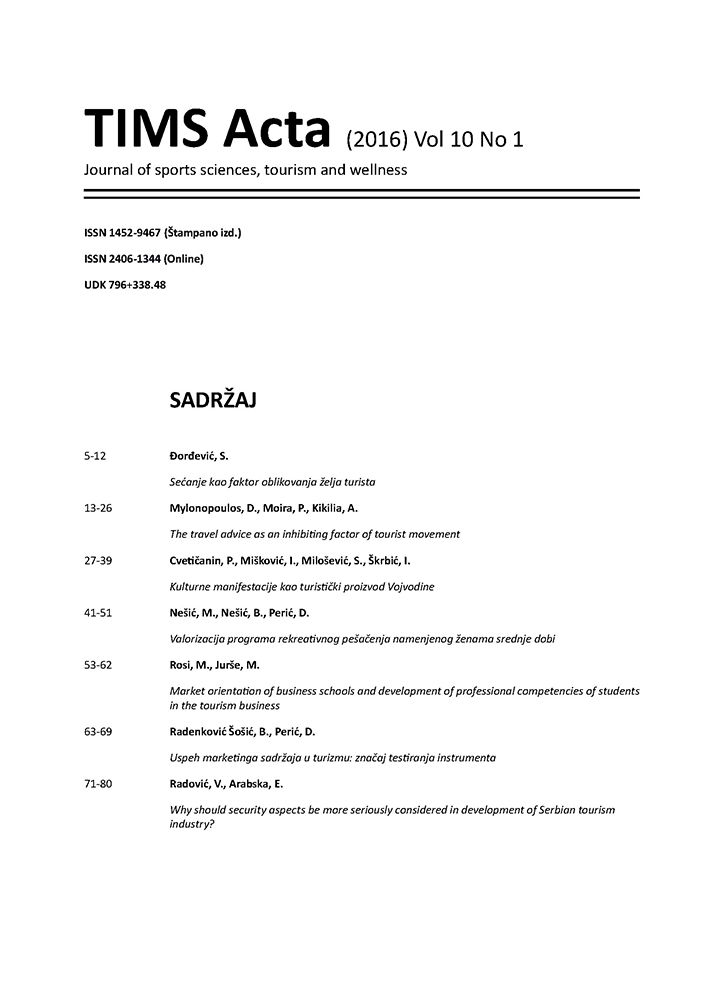MEMORY AS A FACTOR ON SHAPING THE DESIRE OF TOURISTS
Abstract
In the tourist practice and theory, great attention is paid to tourist events and experiences, as to the central element of tourist experience. In addition, what is important for tourists in the tourist cycle is not only to the number of events and tourist attractions, but also the intensity of their perception. Personal experiences are etched deeply in their consciousness and feelings and thus become unforgettable. Memory appears as a complementary categories to experiences, as the other side of the tourist experience and as an important element, making less or more influence on shaping and on character of the interests, needs and desires of tourists, as evidenced by the results of empirical studies that were analyzed in this paper.
Keywords: memory, experience, travel cycle, tourism experience, tourist animation.
References
Barker, C., & Galasinski, D. (2001). Cultural studies and discourse analysis: A dialogue on language and identity. London: Sage publication.
Blanchot, M. (1996). Les intellectuels en question: ébauche d'une réflexion.Fourbis.
Buttle, F. 1993). Hotel and food service marketing: A managerial approach. London: Cassell.
Cooper, C., & Hall, C.M. (2008). Contemporary tourism: An international approach.Routledge.
Čomić, Đ. (1990). Psihologija turizma. Beograd: Turistička štampa.
Čomić, Đ. (2009). Sećanje kao cilj i posledica putovanja. U: Đ. Čomić (Ur.), HOTELPLAN 2009. Beograd: VHŠ.207-213. (10) 13-14.
Đorđević, S. (2010). Uloga doživljaja u turizmu. Hotellink, 11(15-16), 115-120.
Đorđević, S., & Tomka, D. (2011). Koncept lanca animacije u turizmu. Tims acta, 5(2), 70-79.
Đorđević, S. (2012). Post-faza turističkog putovanja u kontekstu komunikacije i animacije turista. Hotellink, 13(19-20), 146-153.
Đorđević, S. (2013). Figurativnost ličnosti turista i turističkih putovanja. Tims acta, 7(1), 21-29.
Đorđević, S. (2014). Kulturni turizam - ključni oblik savremenog turizma. Hotellink, 15(23-24), 157-165.
Graburn, N. (1979). Tourism the scared journey. U: Hosts and Guests. Philadelphia: University of Pennsylvania.
Graburn, N. (1983). The anthropology of tourism. Annals of Tourism Research, 10(1), 9-33. doi:10.1016/0160-7383(83)90047-6
Grenlan, H. (2007). Filozofija osećanja. Beograd: Geopoetika.
Hamilton-Smith, E. (1987). Four kinds of tourism. Annals of Tourism Research, 14(3), 332-344. doi:10.1016/0160-7383(87)90106-x
Herbert, D. (2001). Literary places, tourism and the heritage experience. Annals of Tourism Research, 28(2), 312-333. doi:10.1016/s0160-7383(00)00048-7
Kalmić, L. (2010). Tipologije i kriterijumi za konstrukciju eksplikativnih modela u turističkoj geografiji. VTŠ. Turističko poslovanje, 6, 157-167.
Krippendorf, J. (1986). Putujuće čovečanstvo. Zagreb: SNL, Zavod za istraživanje turizma.
Larsen, S. (2007). Aspects of a Psychology of the Tourist Experience. Scandinavian Journal of Hospitality and Tourism, 7(1), 7-18. doi:10.1080/15022250701226014
Mcintyre, N. (1989). The personal meaning of participation: Enduring involvement. Journal of leisure research, 21(2), 167-179.
Mulvey, L. (1986). On visual and other pleasures.London: Palgrave publishing.
Nosak, T., & Zubanov, V. (2013). Harmonizacija poslovnih i privatnih ciljeva zaposlenih. Tims acta, 7(2), 77-85.
Pine, J. (2004). The authentic experience, travel, and tourism research association. U: Conference. Montreal, Canada 19 June.Conference. Montreal, Canada 19 June.
Scarles, C. (2009). Becoming tourist: renegotiating the visual in the tourist experience. Environment and Planning D: Society and Space, 27(3), 465-488. doi:10.1068/d1707
Suvantola, J. (2002). Tourist's experience of place: New directions in tourism analysis. Ashgate publishing ltd.
Tung, V.W.S., & Ritchie, B.J.R. (2011). Exploring the essence of memorable tourism experiences. Annals of Tourism Research, 38(4), 1367-1386. doi:10.1016/j.annals.2011.03.009
Trauer, B., & Ryan, C. (2005). Destination image, romance and place experience—an application of intimacy theory in tourism. Tourism Management, 26(4), 481-491. doi:10.1016/j.tourman.2004.02.014
Tussyadiah, I.P., & Fesenmaier, D.R. (2009). Mediating Tourist Experiences. Annals of Tourism Research, 36(1), 24-40. doi:10.1016/j.annals.2008.10.001
Štetić, S. (2002). Nove tendencije svetskih turističkih kretanja. Turizam. Novi Sad, 6,
Uriely, N. (2005). The tourist experience. Annals of Tourism Research, 32(1), 199-216. doi:10.1016/j.annals.2004.07.008
Urry, J. (2002). The tourist gaze. Leisure and travel in contemporary societies. 2nd ed. London: Sage publication.
Wang, N. (1999). Rethinking authenticity in tourism experience. Annals of Tourism Research, 26(2), 349-370. doi:10.1016/s0160-7383(98)00103-0
Wang, N. (2000). Tourism and modernity: A sociological analysis. Oxford: Pergamon press.
Zvonarević, M. (1981). Socijalna psihologija.Zagreb: Školska knjiga
Đorđević, S. (2010). Uloga doživljaja u turizmu. Hotellink, 11(15-16), 115-120.
- Autori zadržavaju autorska prava i pružaju časopisu pravo prvog objavljivanja rada i licenciraju ga "Creative Commons Attribution licencom" koja omogućava drugima da dele rad, uz uslov navođenja autorstva i izvornog objavljivanja u ovom časopisu.
- Autori mogu izraditi zasebne, ugovorne aranžmane za neekskluzivnu distribuciju članka objavljenog u časopisu (npr. postavljanje u institucionalni repozitorijum ili objavljivanje u knjizi), uz navođenje da je članak izvorno objavljen u ovom časopisu.
- Autorima je dozvoljeno i podstiču se da postave objavljeni članak onlajn (npr. u institucionalni repozitorijum ili na svoju internet stranicu) pre ili tokom postupka prijave rukopisa, s obzirom da takav postupak može voditi produktivnoj razmeni ideja i ranijoj i većoj citiranosti objavljenog članka (Vidi Efekti otvorenog pristupa).

